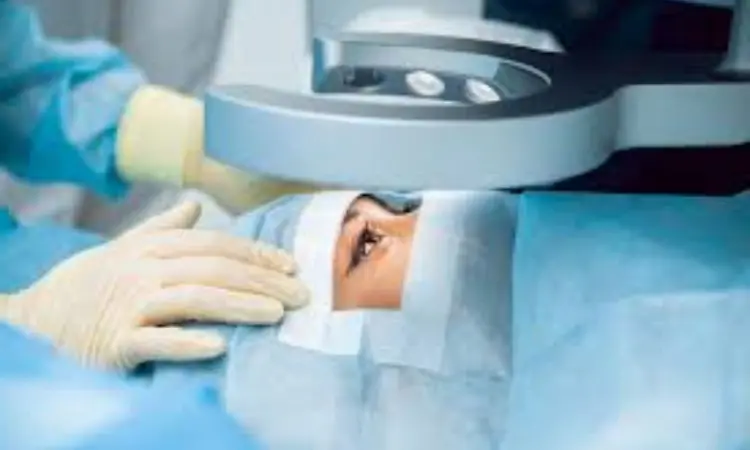- Home
- Medical news & Guidelines
- Anesthesiology
- Cardiology and CTVS
- Critical Care
- Dentistry
- Dermatology
- Diabetes and Endocrinology
- ENT
- Gastroenterology
- Medicine
- Nephrology
- Neurology
- Obstretics-Gynaecology
- Oncology
- Ophthalmology
- Orthopaedics
- Pediatrics-Neonatology
- Psychiatry
- Pulmonology
- Radiology
- Surgery
- Urology
- Laboratory Medicine
- Diet
- Nursing
- Paramedical
- Physiotherapy
- Health news
- Fact Check
- Bone Health Fact Check
- Brain Health Fact Check
- Cancer Related Fact Check
- Child Care Fact Check
- Dental and oral health fact check
- Diabetes and metabolic health fact check
- Diet and Nutrition Fact Check
- Eye and ENT Care Fact Check
- Fitness fact check
- Gut health fact check
- Heart health fact check
- Kidney health fact check
- Medical education fact check
- Men's health fact check
- Respiratory fact check
- Skin and hair care fact check
- Vaccine and Immunization fact check
- Women's health fact check
- AYUSH
- State News
- Andaman and Nicobar Islands
- Andhra Pradesh
- Arunachal Pradesh
- Assam
- Bihar
- Chandigarh
- Chattisgarh
- Dadra and Nagar Haveli
- Daman and Diu
- Delhi
- Goa
- Gujarat
- Haryana
- Himachal Pradesh
- Jammu & Kashmir
- Jharkhand
- Karnataka
- Kerala
- Ladakh
- Lakshadweep
- Madhya Pradesh
- Maharashtra
- Manipur
- Meghalaya
- Mizoram
- Nagaland
- Odisha
- Puducherry
- Punjab
- Rajasthan
- Sikkim
- Tamil Nadu
- Telangana
- Tripura
- Uttar Pradesh
- Uttrakhand
- West Bengal
- Medical Education
- Industry
Less pupil variation in Femtosecond Laser-Assisted Cataract Surgery than Phacoemulsification

Cataract Surgery
Femtosecond laser-assisted cataract surgery (FLACS) emerged as a novel technique in 2009. Since then, this technique has evolved considerably, covering several of the conventional surgical steps previously performed in a manual manner (incisions, lens fragmentation, and capsulotomy). The safety and effectiveness of FLACS is consensually established, with considerable evidence. However, intraoperative miosis has been associated with femtosecond laser-assisted cataract surgery, which renders inherent difficulties regarding nuclear fragmentation, cortex removal, intraocular implantation of the lens, and increases the risk of posterior capsule rupture. This undesired side effect is frequently reported in the vast majority of publications regarding FLACS, which, almost invariably, do not differentiate femtosecond laser based on the pulse pattern, i e, between low and energy pulse femtosecond lasers or do not contemplate low energy pulse at all.
The study by Salgado et al aimed to further investigate on the pupil area changes with low energy pulse FLACS and compare it against the standard phacoemulsification. For this matter, an intraindividual study was performed. This study showed no significant pupil changes, namely myosis, after low-energy FLACS pre-treatment. Comparison between techniques showed less pupil variation in FLACS as compared to CP, more markedly in eyes with comorbidities (particularly with shallow anterior chamber), although non-statistically significant.
A retrospective review of registered surgical data from patients that undergone uncomplicated cataract surgery in a single centre, with randomly assigned femtosecond laser–assisted cataract surgery (FLACS) to one eye and conventional phacoemulsification (CP) to the other, was performed. The recorded pupil images were evaluated at pre and post laser treatment (after suction release) and at several surgical time points for both techniques (FLACS and CP). Pupil areas were calculated and compared in the same eye undergone FLACS (pre vs post laser treatment), between eyes (CP vs FLACS) in the same patient and between groups. Subgroups were built regarding age and ocular comorbidity.
- This study involved a total of 164 eyes of 82 patients. No statistical differences regarding the total duration of surgery (p=0.805) between FLACS and CP.
- Pupil measurements between pre and post laser treatment in the FLACS group showed no statistically significant differences (p=0.107).
- The mean change in pupil area from the beginning until the end of surgery (total variation) was 6.59±2.08 mm2 in the FLACS group and 6.67±2.13 mm2 in the CP group, associated to less narrowing of pupil area with FLACS, although not statistically significant (p=0.080).
- Comorbidity group analysis revealed less, but not significant, pupil narrowing with the FLACS technique (p=0.071).
- No statistically significant differences between FLACS and CP concerning age subgroups were registered.
In conclusion, this intraindividual study provides extended evidence of lack of laser-induced myosis with low-energy FLACS. Furthermore, regarding pupil status, low-energy femtosecond laser-assisted energy seems to compare favorably with conventional phacoemulsification in the presence of certain ocular comorbidities. Although not statistically significant, this difference arises an interesting discussion and, also in line with contemporary literature, it recommends revision of some established, global opinions on FLACS. Further studies on low-energy femtosecond laser-assisted cataract surgery, involving higher samples and rigorous variable control, are in demand for this matter.
Source: Salgado et al; Clinical Ophthalmology 2023:17
https://doi.org/10.2147/OPTH.S399788
Dr Ishan Kataria has done his MBBS from Medical College Bijapur and MS in Ophthalmology from Dr Vasant Rao Pawar Medical College, Nasik. Post completing MD, he pursuid Anterior Segment Fellowship from Sankara Eye Hospital and worked as a competent phaco and anterior segment consultant surgeon in a trust hospital in Bathinda for 2 years.He is currently pursuing Fellowship in Vitreo-Retina at Dr Sohan Singh Eye hospital Amritsar and is actively involved in various research activities under the guidance of the faculty.
Dr Kamal Kant Kohli-MBBS, DTCD- a chest specialist with more than 30 years of practice and a flair for writing clinical articles, Dr Kamal Kant Kohli joined Medical Dialogues as a Chief Editor of Medical News. Besides writing articles, as an editor, he proofreads and verifies all the medical content published on Medical Dialogues including those coming from journals, studies,medical conferences,guidelines etc. Email: drkohli@medicaldialogues.in. Contact no. 011-43720751


